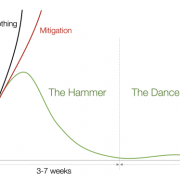Two Core Go-to-Market Principles to Future Proof Growth Post-Disruption
The most pronounced issue this pandemic has brought front and center for revenue leaders is the imperative to operate in ever-smaller ‘windows of certainty’. While this is undoubtedly true in the midst of disruption, it will also be true post-disruption. In fact, it is increasingly clear that for the foreseeable future there will be no obvious demarcation line to define a ‘post-disruption’ environment, and we will be constantly managing through various ripples at both an industry and consumer preference level.
The challenge is that successfully executing in this environment is largely antithetical to the way most organizations have traditionally operated with lengthy planning cycles to develop detailed projects and robust business cases for virtually every initiative. What we see our clients increasingly tasked with is compressing what used to be a 12-month process down to a 1-3 month process. This is the future, and the businesses that can successfully operate and pivot in these compressed timelines will be those that drive forward to growth.
We launched our Revenue Reboot Webinar Series to go deep on a number of critical topics for revenue leaders to begin working through this process. Over the last two months, we have navigated across a number of topics from how to orient around changing buyer journeys, to identifying and winning on the lowest hanging revenue opportunities, to organizing and enabling new go-to-market models.
Across all of these topics, Customer Centricity and Commercial Agility are the two core principles that act as the foundations for future proofing success.
Customer Centricity
What we know about our customers and prospects is increasingly ephemeral. For most organizations, customer research ‘findings’ from 2019 are largely obsolete today. Combine this with an environment across most industries where the customer increasingly has more options, lower switching costs and higher expectations, and the need to have active, ‘always-on’ insights flows have never been more critical.
- In Reboot Customer Retention: Using Data to Idle Defection Risk we cover how organizations can map out the most critical metrics and feedback pathways to drive an ‘always-on’ voice of the customer program. The most critical element is to ensure that all feedback pathways link directly to customer journey points to prescribe specific action.
- In Reboot Your Buyer Experience: Aligning to Your Customers’ New Journey we discuss how to take these insights streams and transform them into an agile understanding of your customer’s journey to optimize sales and marketing investments.
While knowledge of the customer has always been critical for go-to-market strategy, in a world where preferences and behaviors change rapidly, having a constant pulse on these changes and clear linkage to how to drive incremental change is critical.
Commercial Agility
Broadly defined, commercial agility is the ability of an organization to identify opportunities, organize plans against them and execute in increasingly compressed timescales. It pulls from agile software development principles in the need for cross-functional/collaborative dynamics focusing on rapid, evolutionary change.
On the commercial front, we break agility into two separate, but equally important elements:
- Strategic Commercial Agility – the cadence and pace of opportunity focus adjustment and resource re-alignment (i.e. the ability for the organization to structurally adjust itself to new dynamics)
- Operational Commercial Agility – the ability to drive day-to-day execution changes and respond to insights and new information rapidly.
The organizations that can drive commercial agility at both the strategic level and the operational level will be those that will best work through this disruptive period and capitalize on pockets of growth opportunity.
- In Reboot Sales Channels & Territories: Rethinking Geographic Territory-Based Sales Models we discuss how the ever-present geographic territory go-to-market model often impedes strategic agility and we identify some sample alternatives and best practices for organizations to organize into more efficient and flexible dynamics.
- In Reboot Sales Enablement: Arming Sellers in the New Go-to-Market Reality we cover how organizations can operationalize an agile sales enablement paradigm to consistently improve sales effectiveness despite constant industry and buyer changes.
Rebooting Revenue Growth
The reality is that rebooting revenue growth will not be a single set of go-to-market changes, but rather the successful development, implementation, and enablement of a radically different management and execution structure that is engineered with data and insights at the center to identify and respond to customer changes on the fly. These changes will need to come from the top. Revenue leaders across sales and marketing will need to confront the old operational ways with more flexible approaches and drive these mindsets throughout the organization. Outside-in, data-driven, customer-centric, collaborative, and flexible are the themes for future revenue growth.








